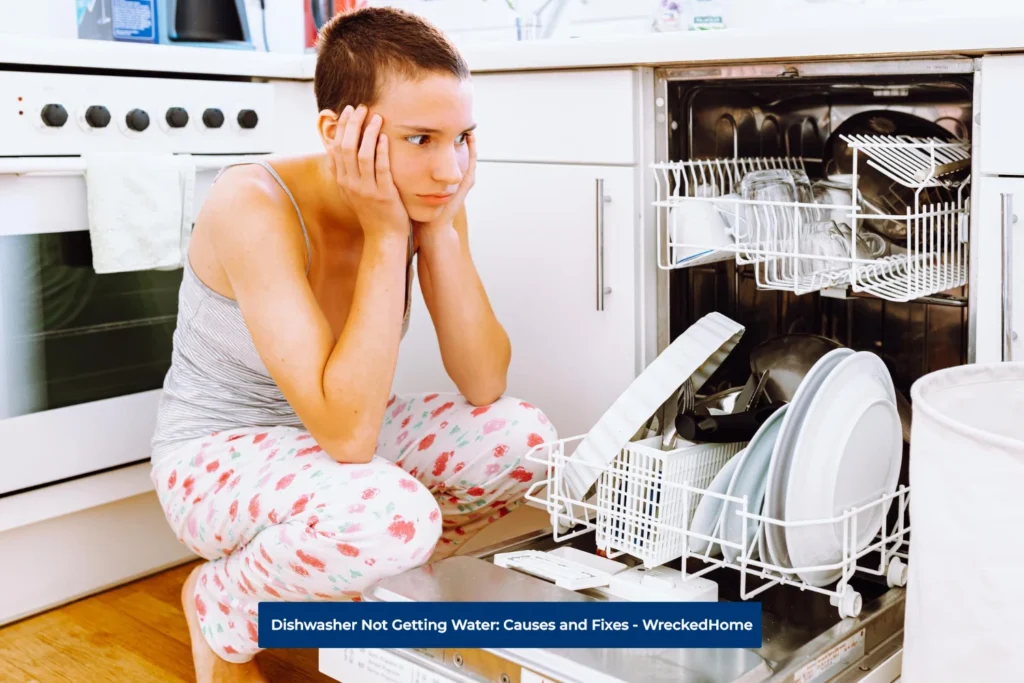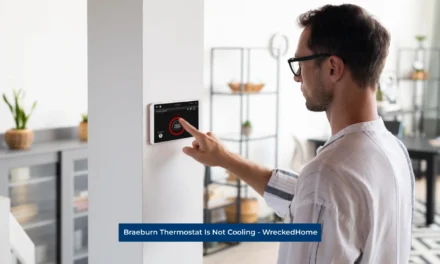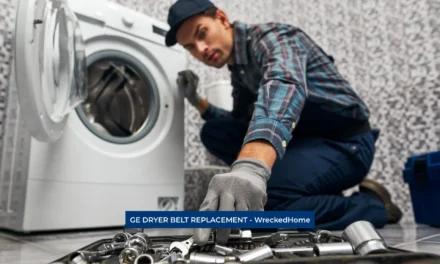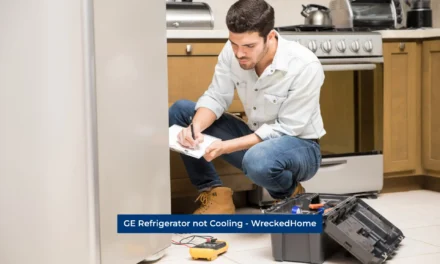Dishwashers are common kitchen appliances. They not only improve your efficiency in the kitchen but also ensure clean and hygienic utensils. Like any other electric appliance, dishwashers also show problems and one on the top of the list is a dishwasher not getting water.
If your dishwasher is also stuck in this problem then don’t fret and thoroughly read this detailed guide. It covers all the causes including wiring issues, inlet valve, faulty pump, kinked water hose or the faulty float switch. Similarly, a faulty door latch or incorrect cycle settings also do their part to make your dishwasher deprived of water. So, let’s take a deeper look into the issue.
- Disconnected or Damaged Wiring (Dishwasher Not Getting Water)
- Clogged Inlet Valve (Dishwasher Not Getting Water)
- Faulty Water Pump (Dishwasher Not Getting Water)
- Kinked Water Hose (Dishwasher Not Getting Water)
- Float Switch Issues (Dishwasher Not Getting Water)
- Faulty Door Latch (Dishwasher Not Getting Water)
- Incorrect Cycle Settings (Dishwasher Not Getting Water)
- Conclusion – Dishwasher not Getting water
Disconnected or Damaged Wiring (Dishwasher Not Getting Water)

If your problem is a dishwasher not getting water and all components are fine then do not forget to check the wiring. Half of the problems in electrical appliances are due to wiring issues. So, it is better to check it first.
| Cause | How to Fix |
| Disconnected or Damaged Wiring | – Turn off the electrical supply. – Locate and inspect the wiring for damage. – Repair or reconnect damaged wires. – Reconnect the panel and test the dishwasher. |
| Clogged Inlet Valve | – Turn off the water supply and disconnect power. – Locate the valve near the kick panel. – Clean the valve to remove mineral deposits. |
| Faulty Water Pump | – Confirm the pump is the issue. – Disconnect power and access the pump. – Inspect for cracks or obstructions. – Repair or replace the pump as needed. |
| Kinked Water Hose | – Examine the water hose for bends or twists. – Straighten the hose or replace it if necessary. |
| Float Switch Issues | – Ensure power and water supply are turned off. – Check the float switch for free movement and clean it. – Test continuity with a multimeter. Replace if faulty. |
| Faulty Door Latch | – Inspect the door latch for damage or misalignment. – Clear debris obstructing the latch. – Tighten screws to fix misalignment. |
| Incorrect Cycle Settings | – Consult the user manual for correct cycle settings. – Reset the cycle if necessary. Select the appropriate cycle. |
How to fix:
Before you begin, turn off the electrical supply to the dishwasher to prevent any hazards. Now locate the wiring. You will find wiring at the bottom of the dishwasher.
So, take a screwdriver and remove the panel. Be sure to be gentle with the unit and do not damage other parts. You will see the wiring after removing the panel. Now carefully inspect the wires for any signs of damage. If you see burns, or disconnections then it clearly means the wiring of your dishwasher is damaged.
You can also find any loose connectors. Simply tighten them to ensure a secure connection. Make sure you insulate the wires to prevent further damage. Check out Our Liquid Insulating Tape to protect the wires. After fixing wiring issues, reconnect panel and turn on the electrical supply to check the status of the problem. If it gets solved, you are good to go. Otherwise, move on to the next reason of dishwasher not getting water unless you get successful.
Clogged Inlet Valve (Dishwasher Not Getting Water)

A clogged inlet valve can be causing your problems because it is one of the most common issues. If you use the dishwasher frequently, you probably know that the inlet valve is really important. This valve controls the flow of water into the appliance. Over time, this valve can get clogged due to mineral deposit or other debris. When this happens, your dishwasher may not fill with water. Or, it may fill very slowly that you feel the dishwasher is not getting water.
How to fix:
The most obvious solution to the clogged inlet vale is cleaning it. Minerals like calcium or magnesium may have been deposited over there. So, first turn off the water supply and disconnect the power to your dishwasher. Safety comes first!
Next locate the valve. You will find it near the kick panel. Deeply examine the valve and check visible signs of mineral deposit. Also take a small brush or a cloth to clean the valve.
Faulty Water Pump (Dishwasher Not Getting Water)
The water pump is the backbone of your dishwasher. It circulates water during the wash and rinse cycle. If your dishwasher not getting water then there is a big possibility that the water pump is faulty.
When this component fails, your dishwasher will not get water and fail to clean dishes.
How to fix:
Before attempting to fix the problem, make sure the water pump is causing the trouble. You can confirm it with the signs like humming sounds or poorly draining dishwasher. Once confirmed, simply disconnect power supply and water to access the pump. Now remove the dishwasher‘s lower front panel. You may need to unscrew a few screws as the pump is usually located near the bottom of the appliance. Now look for any cracks or corrosion. Also figure out any obstructions that are keeping the pump from working smoothly. Remove the obstructions and based on your findings decide whether the pump needs repair or replacement.
Kinked Water Hose (Dishwasher Not Getting Water)
The water hose is the link between your dishwasher and the water supply. It allows water from the supply to enter the dishwasher so it can perform efficiently. Sometimes this water hose gets twisted or kinked and you have no clue about it. As a result, water flow to the dishwasher is compromised and you will face the issue dishwasher not getting water.
How to fix:
Fixing this kinked water hose is the easiest among all. You do not need hefty tools or technical expertise. All you require is the asses to the water hose to straighten it. You can slightly pull the dishwasher for better access to the hose at the back. Use a flashlight to carefully examine the hose. Look for any areas where it might be bent or twisted. Always remember poor installation or tight space can lead to hose bends. Sometimes, the hose quality is also responsible for the kinks. So, depending on the situation, install a new hose or straighten it out for continuous water flow.
Float Switch Issues (Dishwasher Not Getting Water)
The float switch has quite an interesting role in the dishwasher. Its main function is to maintain the water level. For instance, when the dishwasher reaches the proper water level, this float switch signals the machine to stop filling. When the switch malfunctions, your dishwasher will not fill water at all or it may overfill. This is because the switch monitoring the water balance has lost its function. As a result you will say, dishwasher not getting water.
How to fix:
Before fixing the float switch issue, check the power connection and water supply is turned off or not. Make sure to turn them off before beginning the repair work. Next take a screwdriver and multimeter with you.
Now access the float switch. You will find it at the bottom of the dishwasher tub and it looks like a small plastic dome or cylinder. Check the switch for its free movement. Gently lift the switch up and down to notice its action. Clean around it if there is debris.
If you don’t see any improvement in the functioning of the dishwasher then next option is to test the switch. There is a chance that the switch has gone faulty. To do so, take a multimeter and check float switch continuity. A lack of continuity indicates a faulty switch that needs to be replaced.
Faulty Door Latch (Dishwasher Not Getting Water)
If water does not get water after considering all above mentioned reasons then you can think about the door latch. It is a safety feature in dishwashers that ensures the machine operates only when the door is securely closed. If the door latch is faulty or worn out, your machine will neither start a cycle nor fill the water.
How to fix:
Inspection of the door latch is the best way to fix it. Just open the door and examine the latch closely. Look for any signs of damage, wear, or misalignment. Also find the food particles or debris that is obstructing the latch. Now close the door and observe how the latch aligns. You can also fix misaligned latch by tightening the screws.
Incorrect Cycle Settings (Dishwasher Not Getting Water)
If you have a modern dishwasher then there is a chance that incorrect cycle settings have caused the problem, dishwasher not getting water.
The dishwashers work as you guide them. There are multiple cycle settings including quick wash, heavy wash, and rinse or eco-friendly cycles. Picking the wrong cycle can confuse your dishwasher. As a result, your appliance will not fill water or run as you expect it.
How to fix:
Don’t panic if you have identified the problem is in the cycle settings. Take the user manual as a guide to select the correct cycle settings. You will find plenty of information on the document. Find out your preferred cycle depending on your requirements. Similarly, reset the cycle if the machine is already running. You can do it by holding down the ‘reset’ or ‘cancel’ button for a few seconds. Once your dishwasher is reset, use the control panel to select the cycle.
Conclusion – Dishwasher not Getting water
Dishwashers are important these days and you cannot go your whole life doing dishes all alone. These life savers turn into a headache when they show errors or problems like no water in the dishwasher. But, you can solve the problem with simple solutions. You just need some assessment of the problem and figure out the potential reason. The problem gets easily solved once you trace it.
If you still can’t fix your dishwasher after reading this guide, it is time to call in the professionals. Find A Pro Near You Here!





































